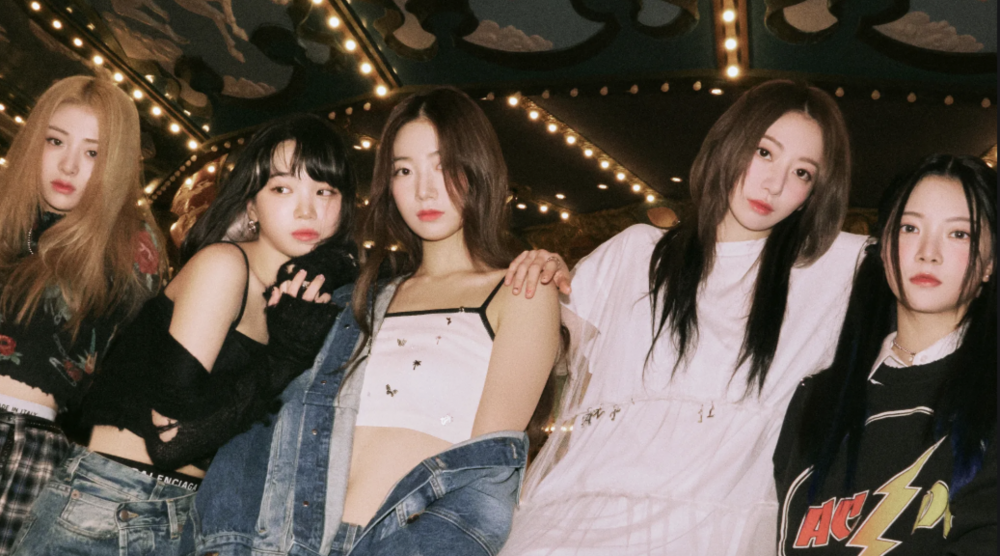
K-Pop, known for its dynamic and ever-evolving nature, outpaces many other sectors in the entertainment industry, particularly within the realm of Korean entertainment. This rapid pace of change is reflected not only in the shifting trends, styles, concepts, designs, and performances but also in the challenges it brings. As the industry witnesses an influx of new idols debuting and established artists making comebacks, one particular issue has increasingly become a focal point of discussion among netizens: the quality of live performances.
In the spotlight recently are LE SSERAFIM, a group that has climbed the charts with hits like “Easy” and “Smart.” However, the buzz around their success isn’t solely due to their chart-topping tracks. Instead, much of the conversation has shifted towards their encore performances, sparking a divide among netizens. This debate centers not on their musical achievements but on the nature of their performances following a win on music shows.
Encore stages, traditionally seen as celebratory laps, have become a hotbed for scrutiny. These typically more relaxed performances offer idols a chance to interact more freely with their fans and show off their personalities. Unlike their meticulously choreographed main stages, encores are less about precision and often see artists move casually around the stage, engaging directly with the audience. It is precisely this laid-back approach that has stirred controversy.
There is one side that argues that LE SSERAFIM's approach to encore performances, which may appear as playful or lacking seriousness, is simply their way of having fun and connecting with fans. On the flip side, there is a growing concern regarding the vocal abilities of the members. The critique is that without the distraction of intense choreography, the encore stages reveal shortcomings in vocal talent, sparking debates about the group's overall musical proficiency.
Now, this isn’t the first time that netizens are divided about how well their favorite idols can sing live. Even previously, many netizens commented on
TWICE Momo’s vocals during the group’s encore performance.
Given that an idol's career in the K-Pop industry hinges on their ability to masterfully sing, dance, and deliver unforgettable performances, there's a growing sense of disappointment among fans regarding some groups' live performance capabilities. The challenge of executing complex dance routines while maintaining vocal precision is undeniably tough, yet this hasn't deterred many idols from showcasing their vocal prowess even in the most demanding moments of their performances.
For instance, Baekhyun, a member of EXO, is renowned for hitting a succession of high notes flawlessly, even amidst the group's rigorous choreography. Similarly, Woohyun from INFINITE has demonstrated exceptional control over his vocals without letting the intensity of his movements affect his singing. Moreover, MAMAMOO stands out as a group where all members consistently deliver live vocals that capture the complexity and strength of their songs, regardless of the choreographic challenges they face on stage.
These examples serve to remind us of the high standards set by previous generations of idols, who managed to balance the dual demands of live singing and intricate dance routines. Their ability to do so has not only raised expectations but also intensified the scrutiny on newer groups.
In addition, these idols had longer songs to perform. Whereas more recent idols' songs barely scratch the three-minute mark, previous idols sang songs that were at the shortest, three minutes long.
So what excuse do the newer generation of idols have? Some netizens claim that it’s just because the choreography is too difficult. But have you seen performances such as
2PM’s “Heartbeat,” EXO’s “Growl”
and “Monster” or even BTS’ “Fire,” G-Friend’s entire discography?
Some people believe that during encore stages, idols aren't seriously trying to sing live; they might even sound bad on purpose, just for a laugh. However, there are many videos available that highlight how often idols are not really singing live during these performances.
K-Pop's focus on physical appearance is not a new phenomenon; the industry has long emphasized visuals alongside talent. However, the claim by some netizens that all one needs to become an idol is an attractive face, neglecting the importance of singing, dancing, and performance skills, oversimplifies the realities of the industry. This perspective underestimates the rigorous training and talent required to succeed in K-Pop, where idols often undergo years of intense preparation before debuting.
The issue of live singing, particularly in the context of its recent criticisms, is multifaceted. On one hand, live performances showcase an idol's raw talent and authenticity, allowing fans to connect with the music on a deeper level. On the other hand, the demanding nature of K-Pop choreographies and the industry's production standards can make live singing challenging, leading to reliance on backing tracks or lip-syncing during particularly strenuous routines.
Considering the global popularity of K-Pop and its reputation for high-energy performances, the debate over live singing versus performance quality is significant. It touches on fundamental questions about what fans value most in their idols and what the industry prioritizes in terms of talent and entertainment. Is the primary goal to deliver flawless vocal performances, or is it to entertain and engage audiences with dynamic shows, even if that means vocals are sometimes supported by backing tracks?
Ultimately, the importance of this debate depends on individual perspectives. Some fans prioritize vocal talent above all, while others may value the overall entertainment experience, including visuals, dance, and stage presence. As K-Pop continues to evolve and reach a wider global audience, the industry may find new ways to balance these elements, perhaps placing greater emphasis on live singing without compromising the spectacular performances that fans love.